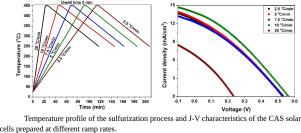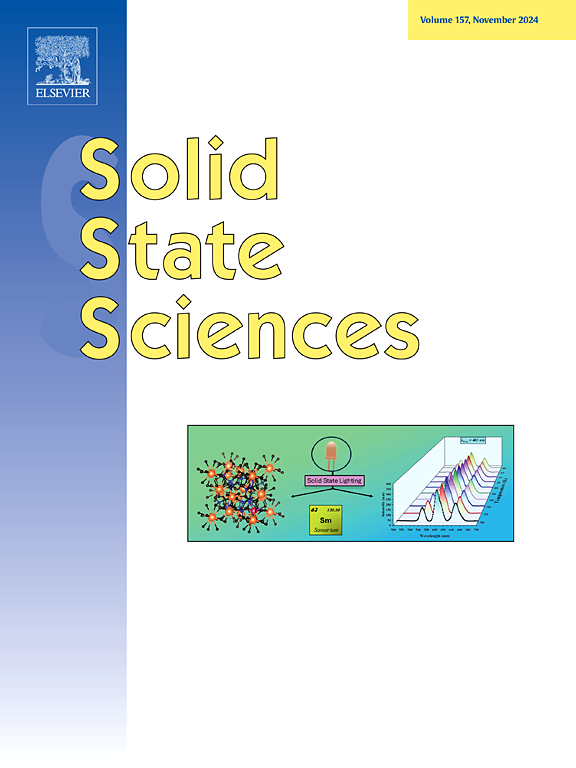斜坡速率对两段式合成CuSbS2吸光材料生长和光电性能的影响
IF 3.3
3区 化学
Q2 CHEMISTRY, INORGANIC & NUCLEAR
引用次数: 0
摘要
前驱体层沉积后再进行硫化是一种广泛采用的制备薄膜太阳能电池的方法。在工艺参数中,硫化过程中的温度斜坡率对CuSbS2 (CAS)吸收层的质量起着至关重要的作用,但其影响尚未得到系统的研究。本研究旨在优化斜坡速率,以促进高质量CAS吸收体的生长,提高太阳能电池的性能。Cu/Sb/Cu前驱体堆在450℃下以2.5 ~ 20℃/min的斜坡速率硫化5 min。最慢的斜坡速率为2.5°C/min,导致金属层完全混合形成CAS,但也导致部分分解,形成Sb2S3第二相,并降低了膜厚度。5、7.5和10°C/min的中间斜坡速率有助于形成具有大微米尺寸晶粒的相纯CAS,并改善了电性能。相比之下,20°C/min的快速斜坡速率会导致表面劣化、空洞形成和二次相。在2.5-10°C/min硫化条件下,用CAS吸收剂制备的太阳能电池的功率转换效率(pce)为2.04-2.50%,短路电流密度(Jsc)为12.20-13.77 mA/cm2,开路电压(Voc)为528.7-568.9 mV,填充系数(FFs)为30.6-31.6%。然而,最快的斜坡速率(20°C/min)会显著降低器件性能。这些发现证明了斜坡速率在获得高质量CAS吸收器和提高太阳能电池效率方面的关键作用。本文章由计算机程序翻译,如有差异,请以英文原文为准。

Effect of ramp rate on the growth and photovoltaic performance of CuSbS2 absorbers synthesized via a two-stage process
Precursor layer deposition followed by sulfurization is a widely adopted method for fabricating thin-film solar cells. Among the process parameters, the temperature ramp rate during sulfurization plays a critical role in determining the quality of CuSbS2 (CAS) absorber layers, yet its influence has not been systematically investigated. This study aims to optimize the ramp rate to enable the growth of high-quality CAS absorbers and improve solar cell performance. Cu/Sb/Cu precursor stacks were sulfurized at 450 °C for 5 min using ramp rates ranging from 2.5 to 20 °C/min. The slowest ramp rate of 2.5 °C/min resulted in complete intermixing of the metal layers to form CAS, but also led to partial decomposition, the formation of an Sb2S3 secondary phase, and reduced film thickness. Intermediate ramp rates of 5, 7.5, and 10 °C/min facilitated the formation of phase-pure CAS with large, micron-sized grains, and improved electrical properties. In contrast, a rapid ramp rate of 20 °C/min caused surface deterioration, void formation, secondary phases. Solar cells fabricated with CAS absorbers sulfurized at 2.5–10 °C/min exhibited power conversion efficiencies (PCEs) of 2.04–2.50%, short-circuit current densities (J) of 12.20–13.77 mA/cm2, open-circuit voltages (V) of 528.7–568.9 mV, and fill factors (FFs) of 30.6–31.6%. However, the fastest ramp rate (20 °C/min) significantly degraded device performance. These findings demonstrate the crucial role of ramp rate in achieving high-quality CAS absorbers and enhancing solar cell efficiency.
求助全文
通过发布文献求助,成功后即可免费获取论文全文。
去求助
来源期刊

Solid State Sciences
化学-无机化学与核化学
CiteScore
6.60
自引率
2.90%
发文量
214
审稿时长
27 days
期刊介绍:
Solid State Sciences is the journal for researchers from the broad solid state chemistry and physics community. It publishes key articles on all aspects of solid state synthesis, structure-property relationships, theory and functionalities, in relation with experiments.
Key topics for stand-alone papers and special issues:
-Novel ways of synthesis, inorganic functional materials, including porous and glassy materials, hybrid organic-inorganic compounds and nanomaterials
-Physical properties, emphasizing but not limited to the electrical, magnetical and optical features
-Materials related to information technology and energy and environmental sciences.
The journal publishes feature articles from experts in the field upon invitation.
Solid State Sciences - your gateway to energy-related materials.
 求助内容:
求助内容: 应助结果提醒方式:
应助结果提醒方式:


